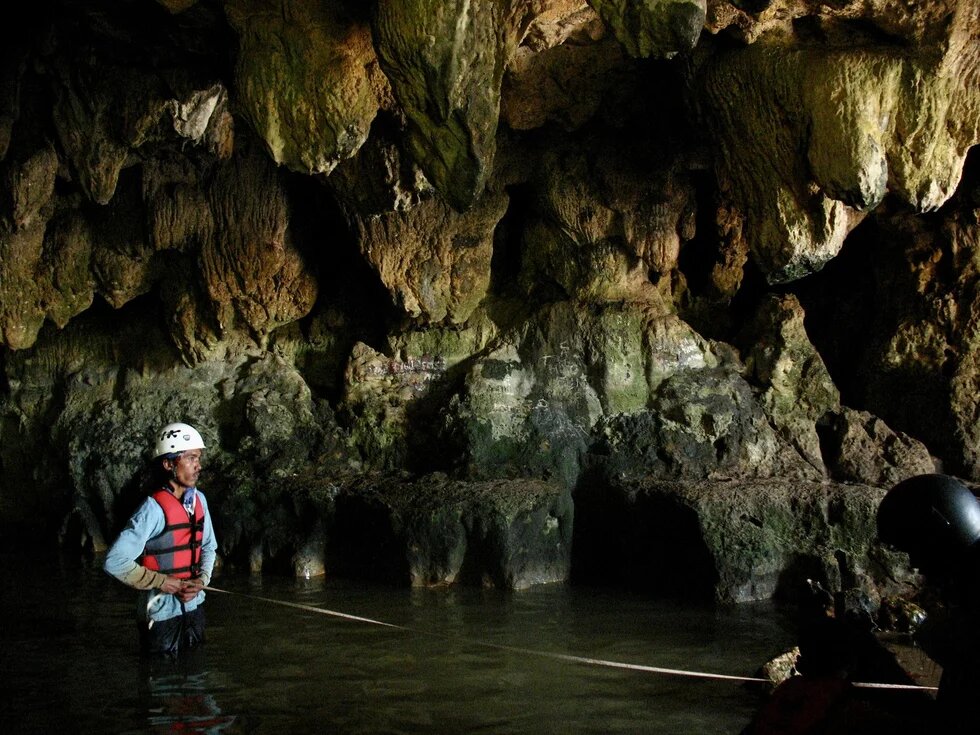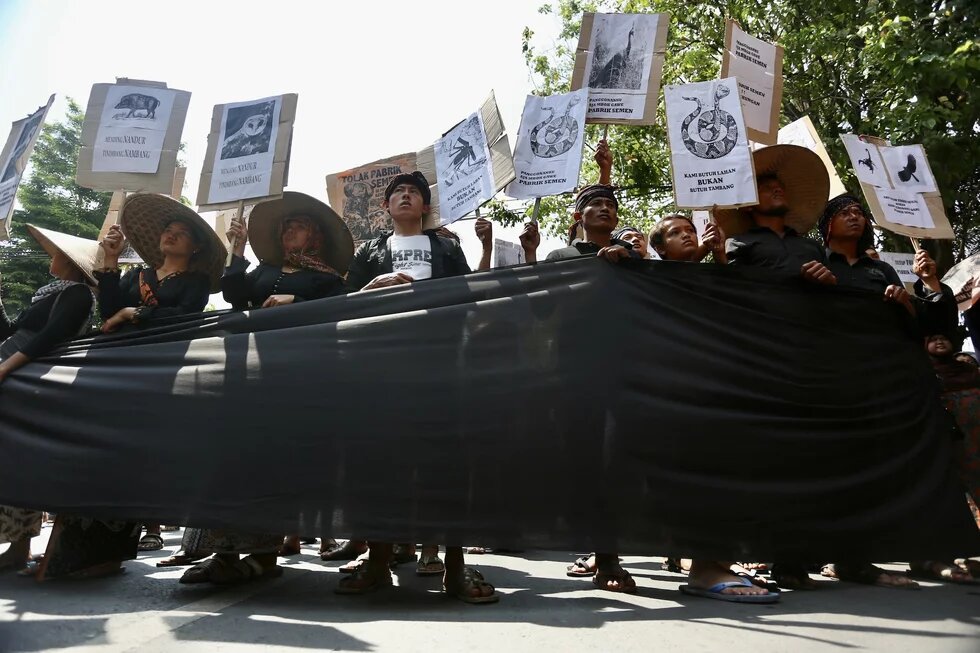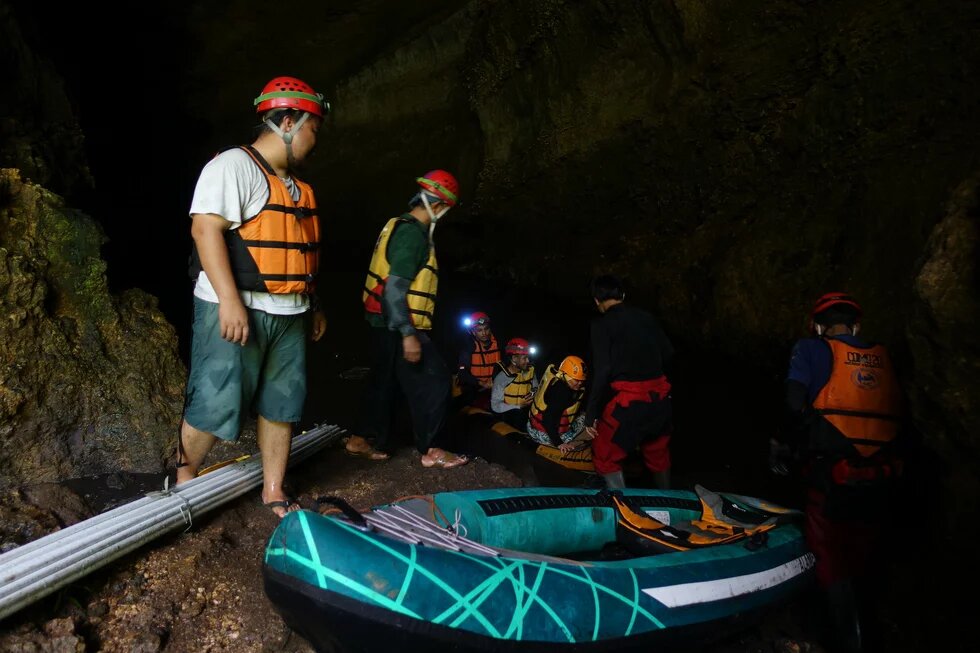
The mineral industry sector is the cause of conflict in various karst regions in Indonesia as companies are keen to exploit natural resources to make cement. But the science of exploring caves – speleology – can help local communities understand the potential of their unique landscapes, contribute to furthering local solidarity, and empower them to make clearer decisions about mining in their areas.

Despite showing a surface landscape that seems quite dry, millions of Indonesians live in karst areas throughout the country. Generally, these people rely on the agricultural sector as their source of income. Communities depend on karst springs for their daily and agricultural needs.
Carbonate minerals which are the main constituents of karst are highly sought after by investors. Mineral carbonate is still the primary raw material for the Portland cement industry, which is hungry for raw materials: to obtain 1 ton of cement, it takes an average of 1.4 tons of limestone. The limestone must be mined, crushed, and burned in very high-temperature furnaces to produce Portland cement.
In addition to the reduced supply of freshwater for villagers, the direct impact of limestone mining is the loss of agricultural land belonging to residents. Land acquisition for cement industry mines is often not balanced with complete information for land-owning farmers and often not done according to the rules.
This is where the unique skills and interests of speleologists can be shared with local communities, in a way that respects, maintains and strengthens their use of karst areas, in sharp opposition to those who wish to take away its resources and leave residents seeking alternatives to meet their daily livelihoods.
Karst as a living space
Karst areas on the island of Java is vital to everyday life, as many residents directly depend on the function of the karst area, especially in terms of land use and the availability of freshwater. Karst relations with the surrounding community have also grown and formed for hundreds of generations. On Java island (mainly in the villages) this relationship has been expressed by performing various kinds of ruwatan (‘maintenance’) ceremonies periodically at karst springs at certain times as a form of respect.
Karst areas are specific and unique landscapes. The cave environment generally develops through the dissolving limestone process, and the landscape consists of the karst surface (exo-karst) and the subsurface karst landscape (endo-karst). In the tropics, the surface of karst landscapes generally shows a dry impression. In tropical karst, the majority of the karst surface is dominated by hills and valleys. The soil resulting from weathering of limestones is transported and accumulated in the valleys, causing the rocks in the limestone hills to become 'naked’ and exposed.
Limestone is a rock type that can absorb and store rainwater, and so has a function as a natural reservoir, freshwater reservoir, and (under certain conditions) petroleum reservoir as well. UNESCO has said that “Groundwater from karst aquifers is very significant, and is the safest source of drinking water” (Forti, 2015). As a sedimentary rock, limestone contains at least 40% carbonate minerals (CaCO3) in its composition. Carbonate minerals are composed of the deposition and rework of various shelled and reef marine animals that died and decomposed millions of years ago.
Conflict of interest in the karst region
Limestone mining has triggered many conflicts in Indonesia, especially between the cement industry (supported by the government) and local farmers. Research published over the years has shown that limestone mining has proven to harm the environment and humans who live around it. In Bogor, West Java, limestone that had been mined and not reclaimed lost 95.8% of its ability to absorb rainwater. Meanwhile, mined limestone and reclaimed limestone absorbed rainwater at only 58% capacity (Djakamihardja & Muhtadi, 2013). As a result, the people living around mining site areas for a dozen years have experienced a freshwater crisis, especially in the dry season.
In the Kendeng area of Central Java, farmers in the Kendeng Mountains have carried out a resistance movement against the exploitation of karst areas for limestone mining since 2006. The majority of farmers who are more environmentally aware will refuse to sell agricultural land for mining, however farmers who are not as informed tend to give up their land, and most of them will have regretted the decision.
The International Union for Conservation of Nature (IUCN) has called for protecting karst areas around the world because they have significant value: as a habitat for flora and fauna, as a religious and spiritual area, as a place for recreation and tourism, as a natural laboratory for science and research, as a part of prehistory and culture, as an area with unique landscapes and rare mineral resources, as a plantation and specific industrial area, and as a key for regional hydrology.
Raising awareness through speleology
Villagers who live in the karst regions have a local understanding of the karst potential, with local knowledge built from generation to generation through long interactions with their surrounding environment. However, many villagers’ comprehension of karst is linked mainly to the springs that are important for their life. They generally don't know about other uses of karst and the deep interest from business for industrial potential.
Speleology is a science that uses caves and their environment as the object of their activities. Not only to study, but also to include activities in the cave, such as adventure, sports and tourism. There are no boundaries in speleology and this makes speleological communities an inclusive entity, with various members from very diverse backgrounds. With a strong base in university-affiliated groups, many speleological activities arise out of campus activists, researchers, and adventurers.
These two communities interact when speleologists come to explore karst communities. Local residents, who live almost entirely in villages, are generally involved in speleological activities only as hosts because their houses are used as field basecamps, or they are porters and guides. But through deeper interactions and shared interest in the commons of karst spaces, speleological surveying and activities have helped to raise awareness of the unique landscape of each community and the value in collecting data.
For example, the Acintyacunyata Speleological Club (ASC), a speleological group based in the district (DI) of Yogyakarta province, conducted a survey with residents across 15 sub-villages about their knowledge of the potential of karst water in Grobogan Regency in 2005–2006. The results showed that the majority of respondents who are farmers know that the water they use for their daily living and farming comes from karst areas. The ASC team also presented and discussed the results of karst potential identification carried out in the area with an audience of key village heads, sub-village heads, and other villagers. The speleological approach has had an impact on the community's perspective on the limestone exploitation plan. Supported by Chinese investors, cement producer Vanda Prima Listri was planning to establish a cement factory in Grobogan in 2004 and through speleology findings, the community is now well aware that caves network under the karst mountain is vital for their agriculture and livelihood.
Practical speleology for farming communities
The Kendeng community, of Sukolilo district in Pati Regency, are predominantly farmers and have good knowledge that the water they use for farming comes from the limestone mountains in their area. The ASC has involved residents as part of the team to collect data on the potential for karst areas, both in searching and GPS's plotting the position of the springs, GPS's plotting of the cave entrance, mapping the cave and measuring water flow. (The involvement of residents in cave mapping is limited to horizontal caves has been decided to minimize the risk of cave exploration.)
Before conducting field activities, the ASC team provided training on the practical knowledge needed to collect data on the potential of the Sukolilo karst area, such as: how to use GPS devices, how to map a cave, how to measure water discharge with a simple method, and a basic introduction to how to use a vertical cave exploration tool. Residents were also introduced to basic knowledge about karst through slide shows, film shows, and discussions every night during the Sukolilo karst data collection activity.
The ASC team processed data collection directly in the field, with daily video documentation. The results have been shown on a projector on a moving basis, from one village to another, either in people's homes or in village fields. This way information could be widely disseminated across the Kendeng community, the majority of whom at that time had agreed with a plan to build a cement factory.
By involving local communities in data collection on the potential of Sukolilo karst, the community can become agents of spreading knowledge about karst based on authentic experiences that they have directly obtained in the field. The majority of people who do not have formal education have confidence because the information they will share is primary information. Not only is the dissemination of this information conducted through discussions held by the ASC team in people's homes or the fields of villages in Sukolilo district, but it has also been undertaken by local women in places residents gather, such as in springs, markets, and at communal gatherings of residents.
Reproduction of karst knowledge for the next generation
The Kendeng movement has been running for 16 years and continuously fighting the exploitation of nature by the cement industry till the present day. It has grown from a resident movement into national issues, even becoming an international issue with involvement from activists focusing on climate change issues in Germany. Unfortunately, the movement has spent a significant amount of resources from those active in it, and several who were involved at the beginning have started to withdraw due to age and various other reasons.
The Kendeng movement has now entered a period where the younger generation is at the forefront. The younger members have great energy to continue the movement through various mediums. But is speleological knowledge still being reproduced and passed on to the next generation?
A limited survey of online questionnaires was distributed to the Kendeng community in early 2022 to determine the current level of community understanding of basic speleology (karst and caves). Receiving responses from 27 Kendeng farmers, over 90% of respondents understand what karst is and its benefits for the people living in the vicinity, especially the function of karst as a freshwater aquifer. More than 80% of respondents recognize the fauna with caves as their habitat, and 95% of the community know that the cave fauna (in this case, the bat) is very beneficial for agriculture around the karst area. Almost half of respondents claimed to have received information about karst from their family, over a third received information about karst from the media, and one in six received information about karst from their neighbors or friends.
What is interesting from this limited survey is the role of the family in reproducing karst knowledge in the Kendeng community. All respondents aged 12–17 years received karst information from their families, while respondents over the age of 17 on average got karst information from their interactions with other people, newspapers, online media, and television. The majority of respondents (over 75%) expect additional karst knowledge and the most desirable method to learn is through direct field visits and discussions.
__
A.B. Rodhial Falah is researcher on Speleology (study and exploration of caves) and filmmaker. He has written articles and publication on speleology and karst ecosystem and has produced news documentary on the topic of Environment, Energy, Pollution and Climate Change in Indonesia, mostly for the Global Ideas series for Deutsche Welle. He holds Bachelor of Geology Engineering from National Institute of Technology, Yogyakarta.
The views expressed in this article are not necessarily those of Heinrich Böll Stiftung.


